BSBMGT608: Innovation Management & Continuous Improvement Analysis
VerifiedAdded on 2024/06/07
|21
|3984
|369
Report
AI Summary
This assignment solution focuses on BSBMGT608 Manage Innovation and Continuous Improvement, addressing key aspects such as quality management theories (Deming, Crosby, Juran, Ishikawa, EFQM), Kotter's 8-step change model, diffusion of innovation theory, ISO 9000 standards, cost-benefit analysis, and the concept of a learning organization. It further explores shared vision, team learning, sustainability practices in Australian workplaces, and risk management according to AS/NZS ISO 31000:2009. The project review section introduces a sustainability program for Woodhouse Recruitment, emphasizing staff professional development and green office initiatives, supply chain optimization and quality management systems. The assignment also touches upon staff professional development and risk management strategies. Desklib provides access to this and other solved assignments to aid students in their studies.
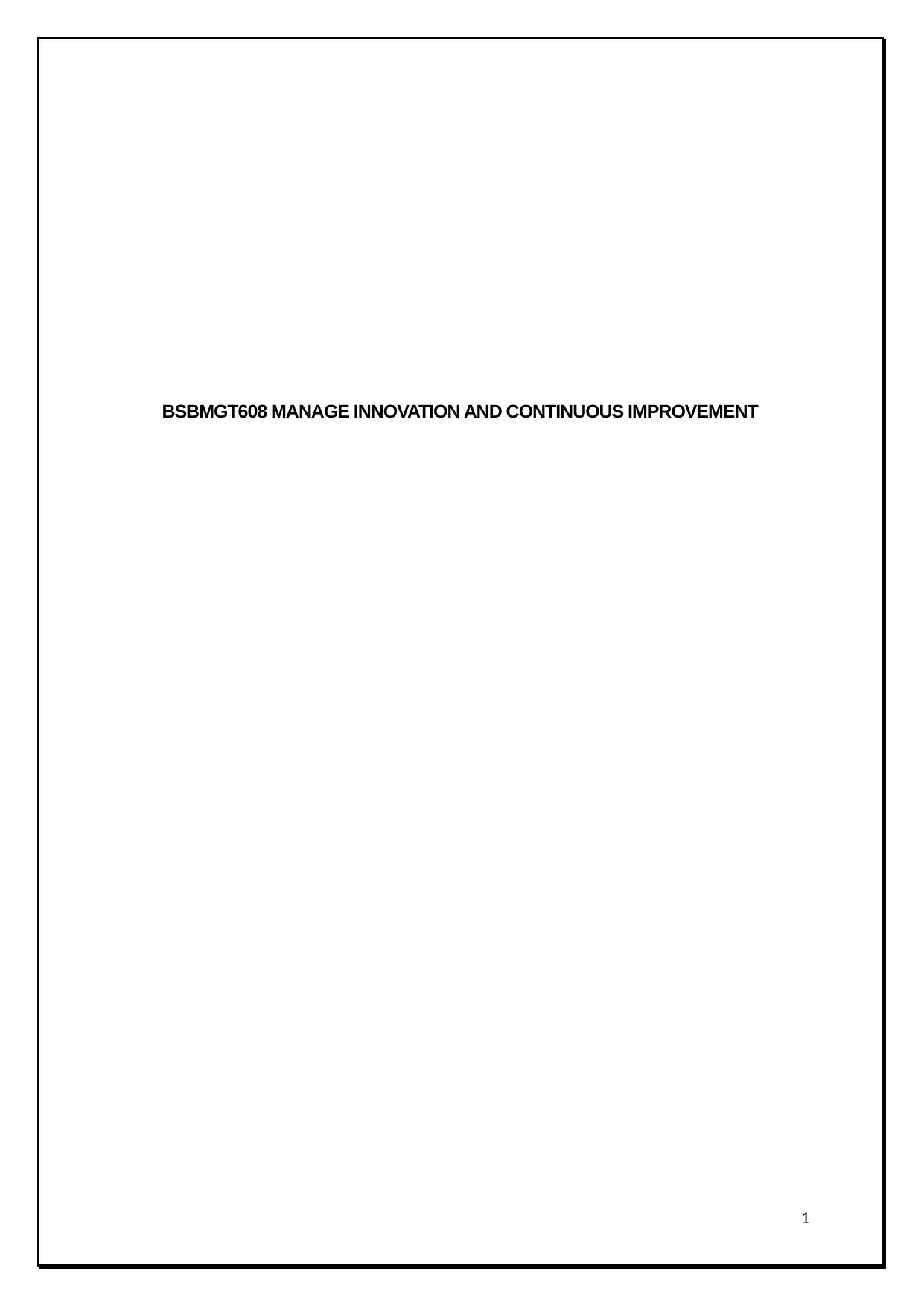
BSBMGT608 MANAGE INNOVATION AND CONTINUOUS IMPROVEMENT
1
1
Paraphrase This Document
Need a fresh take? Get an instant paraphrase of this document with our AI Paraphraser
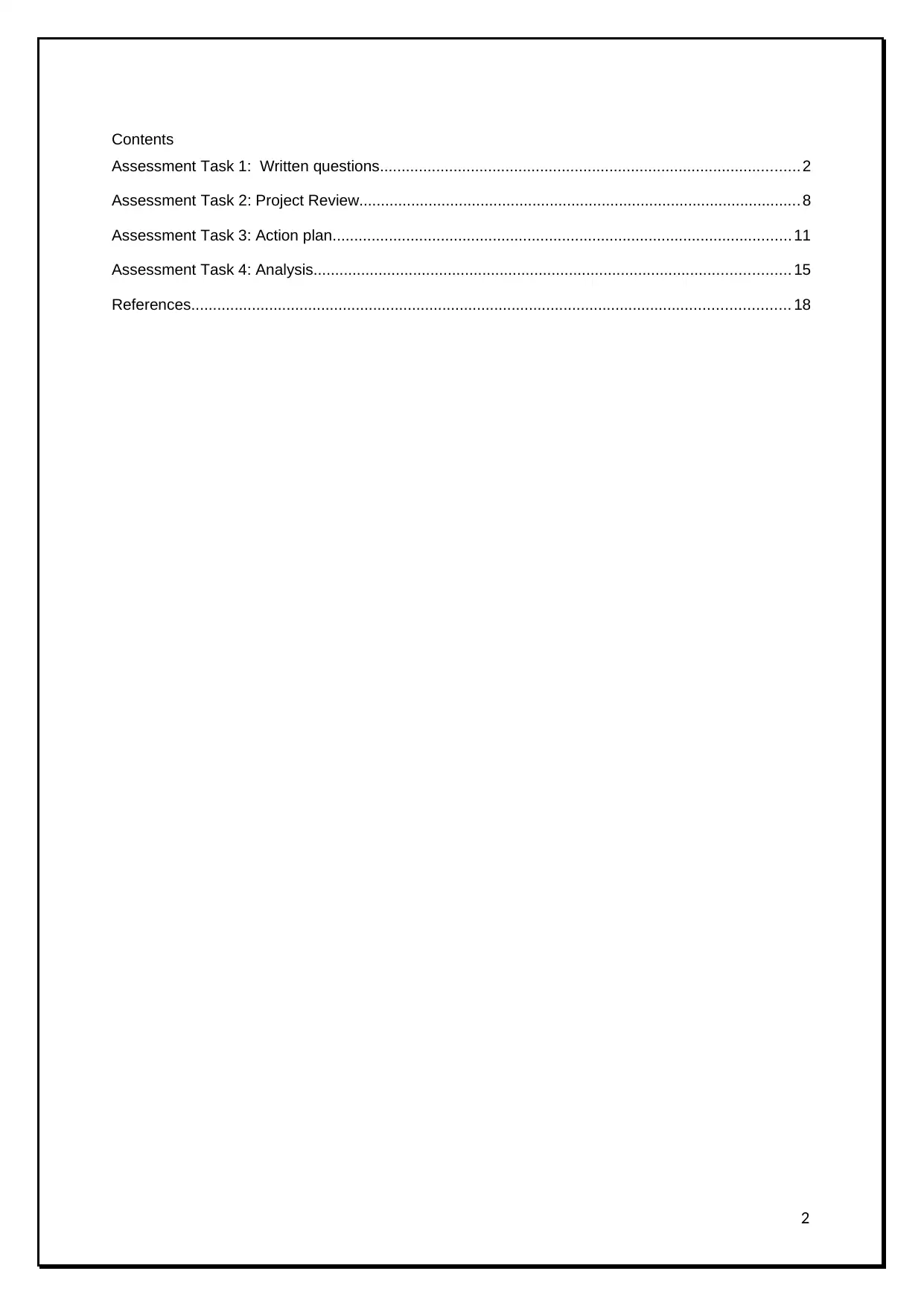
Contents
Assessment Task 1: Written questions................................................................................................. 2
Assessment Task 2: Project Review...................................................................................................... 8
Assessment Task 3: Action plan.......................................................................................................... 11
Assessment Task 4: Analysis.............................................................................................................. 15
References.......................................................................................................................................... 18
2
Assessment Task 1: Written questions................................................................................................. 2
Assessment Task 2: Project Review...................................................................................................... 8
Assessment Task 3: Action plan.......................................................................................................... 11
Assessment Task 4: Analysis.............................................................................................................. 15
References.......................................................................................................................................... 18
2
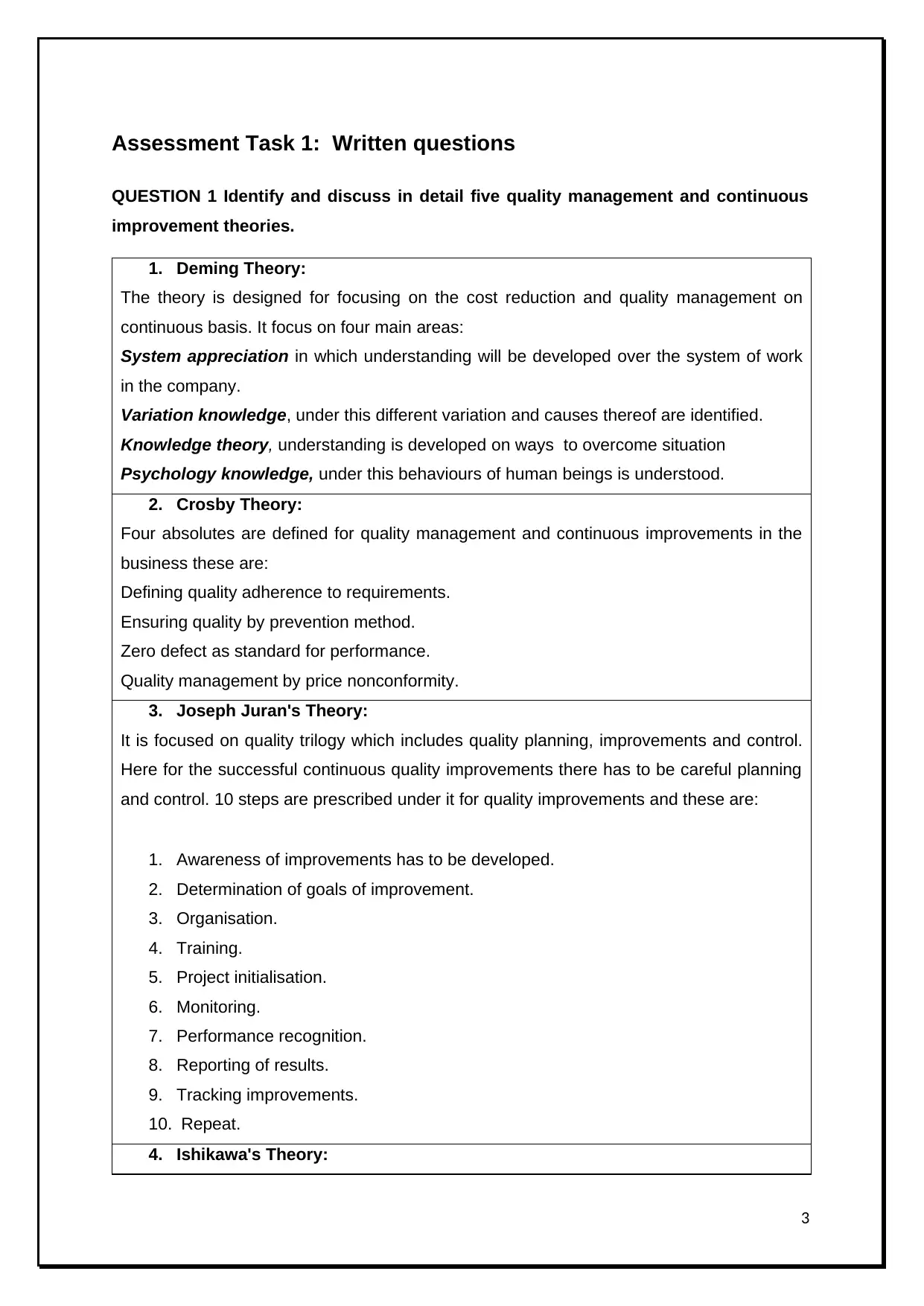
Assessment Task 1: Written questions
QUESTION 1 Identify and discuss in detail five quality management and continuous
improvement theories.
1. Deming Theory:
The theory is designed for focusing on the cost reduction and quality management on
continuous basis. It focus on four main areas:
System appreciation in which understanding will be developed over the system of work
in the company.
Variation knowledge, under this different variation and causes thereof are identified.
Knowledge theory, understanding is developed on ways to overcome situation
Psychology knowledge, under this behaviours of human beings is understood.
2. Crosby Theory:
Four absolutes are defined for quality management and continuous improvements in the
business these are:
Defining quality adherence to requirements.
Ensuring quality by prevention method.
Zero defect as standard for performance.
Quality management by price nonconformity.
3. Joseph Juran's Theory:
It is focused on quality trilogy which includes quality planning, improvements and control.
Here for the successful continuous quality improvements there has to be careful planning
and control. 10 steps are prescribed under it for quality improvements and these are:
1. Awareness of improvements has to be developed.
2. Determination of goals of improvement.
3. Organisation.
4. Training.
5. Project initialisation.
6. Monitoring.
7. Performance recognition.
8. Reporting of results.
9. Tracking improvements.
10. Repeat.
4. Ishikawa's Theory:
3
QUESTION 1 Identify and discuss in detail five quality management and continuous
improvement theories.
1. Deming Theory:
The theory is designed for focusing on the cost reduction and quality management on
continuous basis. It focus on four main areas:
System appreciation in which understanding will be developed over the system of work
in the company.
Variation knowledge, under this different variation and causes thereof are identified.
Knowledge theory, understanding is developed on ways to overcome situation
Psychology knowledge, under this behaviours of human beings is understood.
2. Crosby Theory:
Four absolutes are defined for quality management and continuous improvements in the
business these are:
Defining quality adherence to requirements.
Ensuring quality by prevention method.
Zero defect as standard for performance.
Quality management by price nonconformity.
3. Joseph Juran's Theory:
It is focused on quality trilogy which includes quality planning, improvements and control.
Here for the successful continuous quality improvements there has to be careful planning
and control. 10 steps are prescribed under it for quality improvements and these are:
1. Awareness of improvements has to be developed.
2. Determination of goals of improvement.
3. Organisation.
4. Training.
5. Project initialisation.
6. Monitoring.
7. Performance recognition.
8. Reporting of results.
9. Tracking improvements.
10. Repeat.
4. Ishikawa's Theory:
3
⊘ This is a preview!⊘
Do you want full access?
Subscribe today to unlock all pages.

Trusted by 1+ million students worldwide
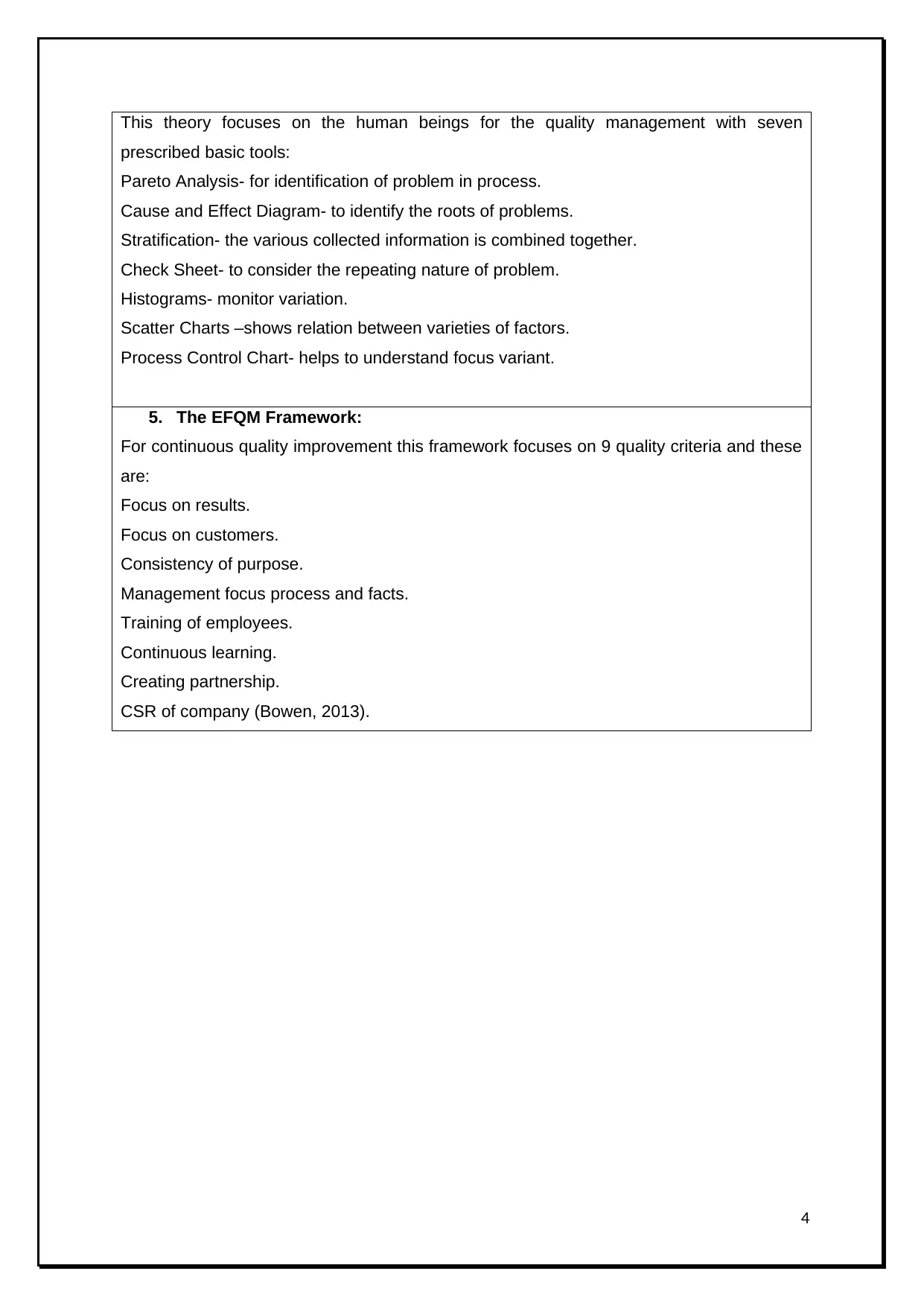
This theory focuses on the human beings for the quality management with seven
prescribed basic tools:
Pareto Analysis- for identification of problem in process.
Cause and Effect Diagram- to identify the roots of problems.
Stratification- the various collected information is combined together.
Check Sheet- to consider the repeating nature of problem.
Histograms- monitor variation.
Scatter Charts –shows relation between varieties of factors.
Process Control Chart- helps to understand focus variant.
5. The EFQM Framework:
For continuous quality improvement this framework focuses on 9 quality criteria and these
are:
Focus on results.
Focus on customers.
Consistency of purpose.
Management focus process and facts.
Training of employees.
Continuous learning.
Creating partnership.
CSR of company (Bowen, 2013).
4
prescribed basic tools:
Pareto Analysis- for identification of problem in process.
Cause and Effect Diagram- to identify the roots of problems.
Stratification- the various collected information is combined together.
Check Sheet- to consider the repeating nature of problem.
Histograms- monitor variation.
Scatter Charts –shows relation between varieties of factors.
Process Control Chart- helps to understand focus variant.
5. The EFQM Framework:
For continuous quality improvement this framework focuses on 9 quality criteria and these
are:
Focus on results.
Focus on customers.
Consistency of purpose.
Management focus process and facts.
Training of employees.
Continuous learning.
Creating partnership.
CSR of company (Bowen, 2013).
4
Paraphrase This Document
Need a fresh take? Get an instant paraphrase of this document with our AI Paraphraser
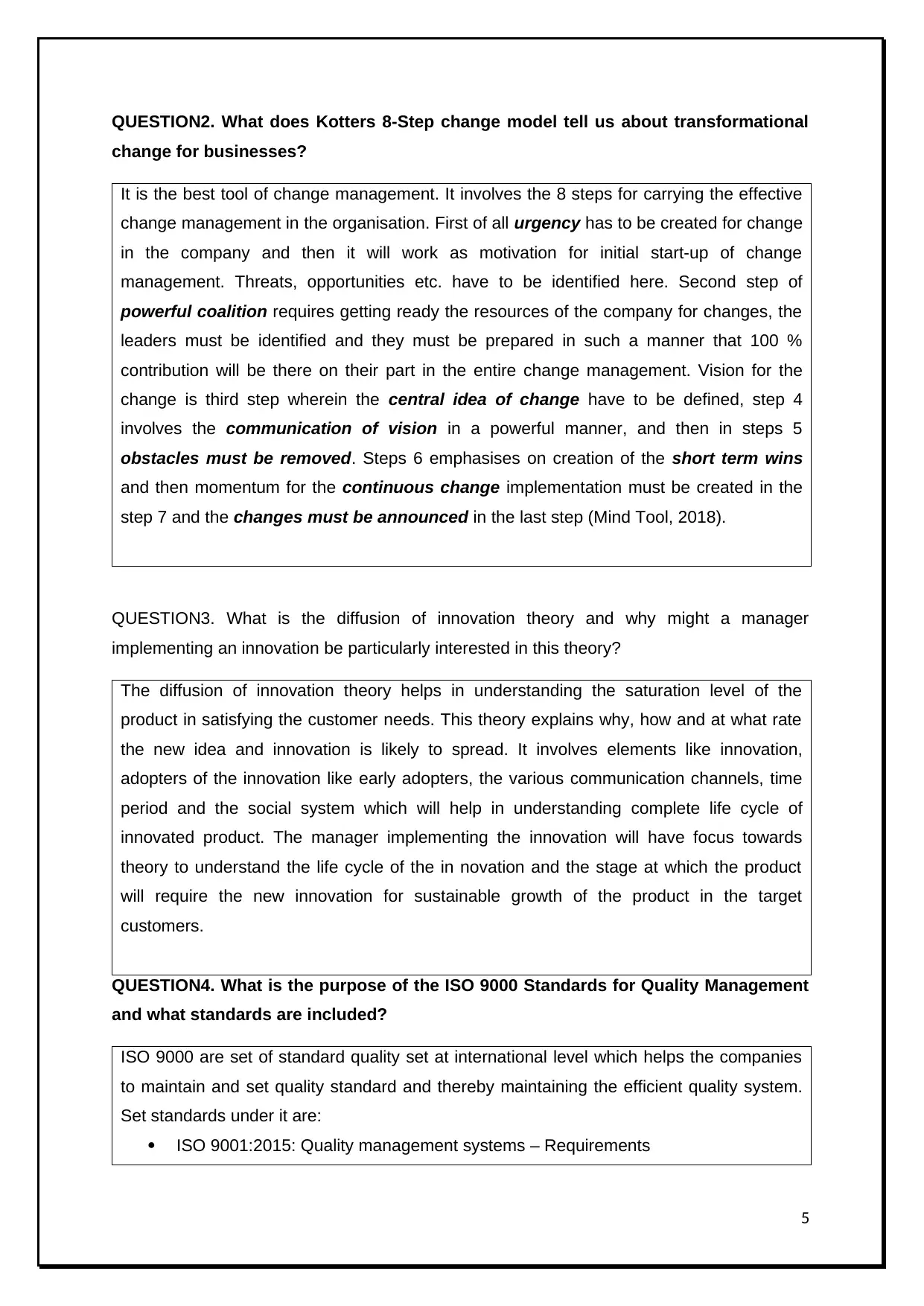
QUESTION2. What does Kotters 8-Step change model tell us about transformational
change for businesses?
It is the best tool of change management. It involves the 8 steps for carrying the effective
change management in the organisation. First of all urgency has to be created for change
in the company and then it will work as motivation for initial start-up of change
management. Threats, opportunities etc. have to be identified here. Second step of
powerful coalition requires getting ready the resources of the company for changes, the
leaders must be identified and they must be prepared in such a manner that 100 %
contribution will be there on their part in the entire change management. Vision for the
change is third step wherein the central idea of change have to be defined, step 4
involves the communication of vision in a powerful manner, and then in steps 5
obstacles must be removed. Steps 6 emphasises on creation of the short term wins
and then momentum for the continuous change implementation must be created in the
step 7 and the changes must be announced in the last step (Mind Tool, 2018).
QUESTION3. What is the diffusion of innovation theory and why might a manager
implementing an innovation be particularly interested in this theory?
The diffusion of innovation theory helps in understanding the saturation level of the
product in satisfying the customer needs. This theory explains why, how and at what rate
the new idea and innovation is likely to spread. It involves elements like innovation,
adopters of the innovation like early adopters, the various communication channels, time
period and the social system which will help in understanding complete life cycle of
innovated product. The manager implementing the innovation will have focus towards
theory to understand the life cycle of the in novation and the stage at which the product
will require the new innovation for sustainable growth of the product in the target
customers.
QUESTION4. What is the purpose of the ISO 9000 Standards for Quality Management
and what standards are included?
ISO 9000 are set of standard quality set at international level which helps the companies
to maintain and set quality standard and thereby maintaining the efficient quality system.
Set standards under it are:
ISO 9001:2015: Quality management systems – Requirements
5
change for businesses?
It is the best tool of change management. It involves the 8 steps for carrying the effective
change management in the organisation. First of all urgency has to be created for change
in the company and then it will work as motivation for initial start-up of change
management. Threats, opportunities etc. have to be identified here. Second step of
powerful coalition requires getting ready the resources of the company for changes, the
leaders must be identified and they must be prepared in such a manner that 100 %
contribution will be there on their part in the entire change management. Vision for the
change is third step wherein the central idea of change have to be defined, step 4
involves the communication of vision in a powerful manner, and then in steps 5
obstacles must be removed. Steps 6 emphasises on creation of the short term wins
and then momentum for the continuous change implementation must be created in the
step 7 and the changes must be announced in the last step (Mind Tool, 2018).
QUESTION3. What is the diffusion of innovation theory and why might a manager
implementing an innovation be particularly interested in this theory?
The diffusion of innovation theory helps in understanding the saturation level of the
product in satisfying the customer needs. This theory explains why, how and at what rate
the new idea and innovation is likely to spread. It involves elements like innovation,
adopters of the innovation like early adopters, the various communication channels, time
period and the social system which will help in understanding complete life cycle of
innovated product. The manager implementing the innovation will have focus towards
theory to understand the life cycle of the in novation and the stage at which the product
will require the new innovation for sustainable growth of the product in the target
customers.
QUESTION4. What is the purpose of the ISO 9000 Standards for Quality Management
and what standards are included?
ISO 9000 are set of standard quality set at international level which helps the companies
to maintain and set quality standard and thereby maintaining the efficient quality system.
Set standards under it are:
ISO 9001:2015: Quality management systems – Requirements
5
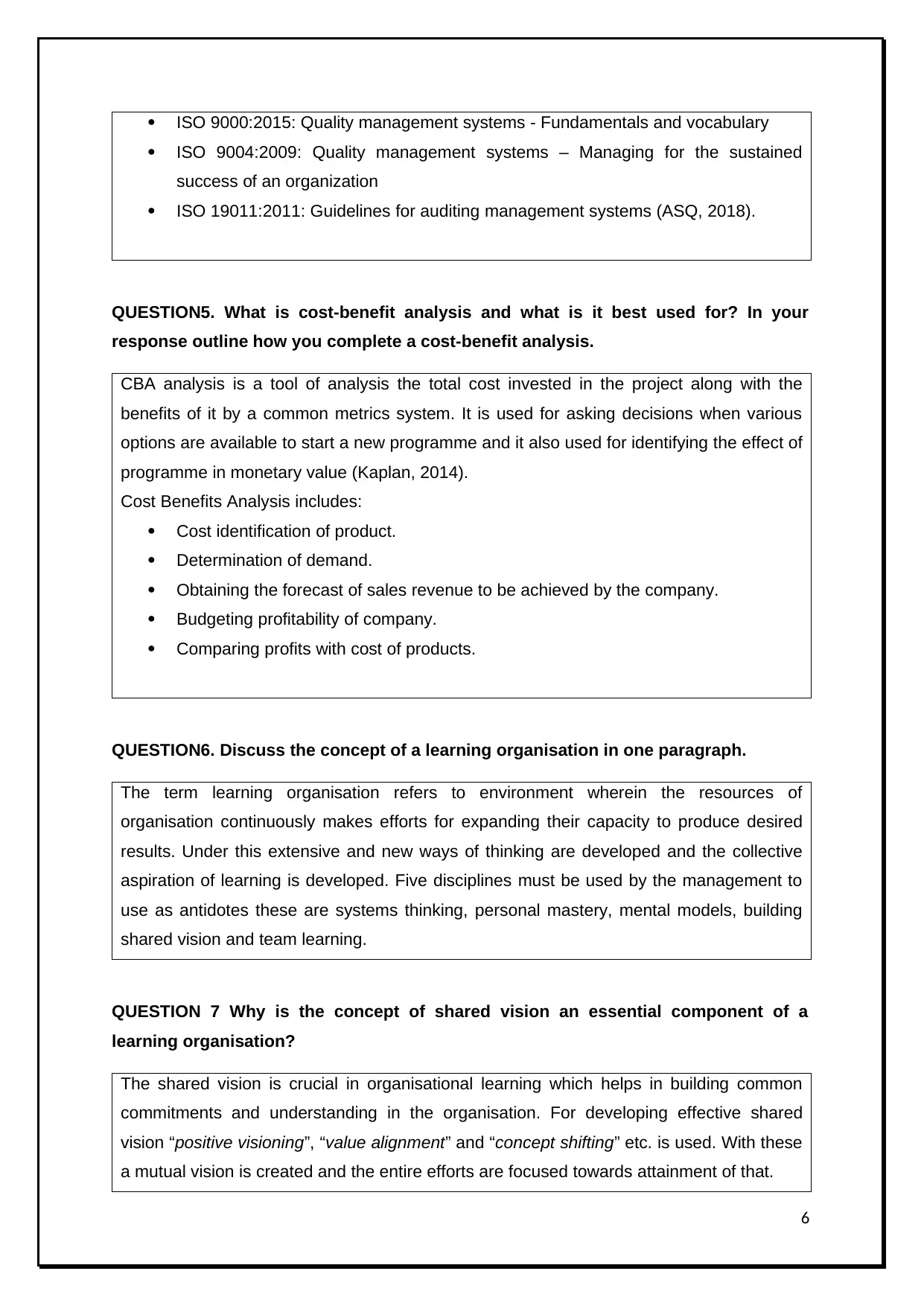
ISO 9000:2015: Quality management systems - Fundamentals and vocabulary
ISO 9004:2009: Quality management systems – Managing for the sustained
success of an organization
ISO 19011:2011: Guidelines for auditing management systems (ASQ, 2018).
QUESTION5. What is cost-benefit analysis and what is it best used for? In your
response outline how you complete a cost-benefit analysis.
CBA analysis is a tool of analysis the total cost invested in the project along with the
benefits of it by a common metrics system. It is used for asking decisions when various
options are available to start a new programme and it also used for identifying the effect of
programme in monetary value (Kaplan, 2014).
Cost Benefits Analysis includes:
Cost identification of product.
Determination of demand.
Obtaining the forecast of sales revenue to be achieved by the company.
Budgeting profitability of company.
Comparing profits with cost of products.
QUESTION6. Discuss the concept of a learning organisation in one paragraph.
The term learning organisation refers to environment wherein the resources of
organisation continuously makes efforts for expanding their capacity to produce desired
results. Under this extensive and new ways of thinking are developed and the collective
aspiration of learning is developed. Five disciplines must be used by the management to
use as antidotes these are systems thinking, personal mastery, mental models, building
shared vision and team learning.
QUESTION 7 Why is the concept of shared vision an essential component of a
learning organisation?
The shared vision is crucial in organisational learning which helps in building common
commitments and understanding in the organisation. For developing effective shared
vision “positive visioning”, “value alignment” and “concept shifting” etc. is used. With these
a mutual vision is created and the entire efforts are focused towards attainment of that.
6
ISO 9004:2009: Quality management systems – Managing for the sustained
success of an organization
ISO 19011:2011: Guidelines for auditing management systems (ASQ, 2018).
QUESTION5. What is cost-benefit analysis and what is it best used for? In your
response outline how you complete a cost-benefit analysis.
CBA analysis is a tool of analysis the total cost invested in the project along with the
benefits of it by a common metrics system. It is used for asking decisions when various
options are available to start a new programme and it also used for identifying the effect of
programme in monetary value (Kaplan, 2014).
Cost Benefits Analysis includes:
Cost identification of product.
Determination of demand.
Obtaining the forecast of sales revenue to be achieved by the company.
Budgeting profitability of company.
Comparing profits with cost of products.
QUESTION6. Discuss the concept of a learning organisation in one paragraph.
The term learning organisation refers to environment wherein the resources of
organisation continuously makes efforts for expanding their capacity to produce desired
results. Under this extensive and new ways of thinking are developed and the collective
aspiration of learning is developed. Five disciplines must be used by the management to
use as antidotes these are systems thinking, personal mastery, mental models, building
shared vision and team learning.
QUESTION 7 Why is the concept of shared vision an essential component of a
learning organisation?
The shared vision is crucial in organisational learning which helps in building common
commitments and understanding in the organisation. For developing effective shared
vision “positive visioning”, “value alignment” and “concept shifting” etc. is used. With these
a mutual vision is created and the entire efforts are focused towards attainment of that.
6
⊘ This is a preview!⊘
Do you want full access?
Subscribe today to unlock all pages.

Trusted by 1+ million students worldwide
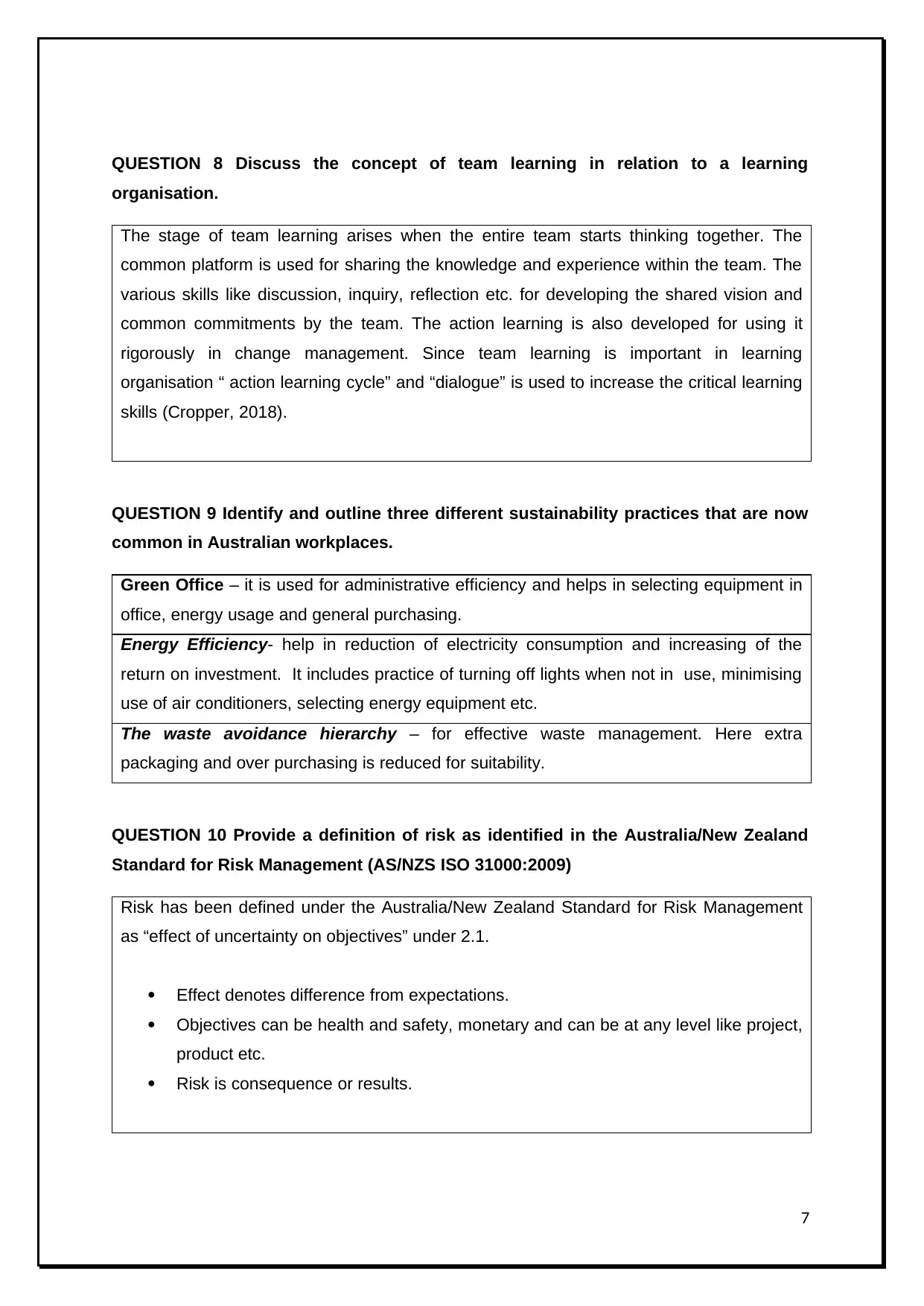
QUESTION 8 Discuss the concept of team learning in relation to a learning
organisation.
The stage of team learning arises when the entire team starts thinking together. The
common platform is used for sharing the knowledge and experience within the team. The
various skills like discussion, inquiry, reflection etc. for developing the shared vision and
common commitments by the team. The action learning is also developed for using it
rigorously in change management. Since team learning is important in learning
organisation “ action learning cycle” and “dialogue” is used to increase the critical learning
skills (Cropper, 2018).
QUESTION 9 Identify and outline three different sustainability practices that are now
common in Australian workplaces.
Green Office – it is used for administrative efficiency and helps in selecting equipment in
office, energy usage and general purchasing.
Energy Efficiency- help in reduction of electricity consumption and increasing of the
return on investment. It includes practice of turning off lights when not in use, minimising
use of air conditioners, selecting energy equipment etc.
The waste avoidance hierarchy – for effective waste management. Here extra
packaging and over purchasing is reduced for suitability.
QUESTION 10 Provide a definition of risk as identified in the Australia/New Zealand
Standard for Risk Management (AS/NZS ISO 31000:2009)
Risk has been defined under the Australia/New Zealand Standard for Risk Management
as “effect of uncertainty on objectives” under 2.1.
Effect denotes difference from expectations.
Objectives can be health and safety, monetary and can be at any level like project,
product etc.
Risk is consequence or results.
7
organisation.
The stage of team learning arises when the entire team starts thinking together. The
common platform is used for sharing the knowledge and experience within the team. The
various skills like discussion, inquiry, reflection etc. for developing the shared vision and
common commitments by the team. The action learning is also developed for using it
rigorously in change management. Since team learning is important in learning
organisation “ action learning cycle” and “dialogue” is used to increase the critical learning
skills (Cropper, 2018).
QUESTION 9 Identify and outline three different sustainability practices that are now
common in Australian workplaces.
Green Office – it is used for administrative efficiency and helps in selecting equipment in
office, energy usage and general purchasing.
Energy Efficiency- help in reduction of electricity consumption and increasing of the
return on investment. It includes practice of turning off lights when not in use, minimising
use of air conditioners, selecting energy equipment etc.
The waste avoidance hierarchy – for effective waste management. Here extra
packaging and over purchasing is reduced for suitability.
QUESTION 10 Provide a definition of risk as identified in the Australia/New Zealand
Standard for Risk Management (AS/NZS ISO 31000:2009)
Risk has been defined under the Australia/New Zealand Standard for Risk Management
as “effect of uncertainty on objectives” under 2.1.
Effect denotes difference from expectations.
Objectives can be health and safety, monetary and can be at any level like project,
product etc.
Risk is consequence or results.
7
Paraphrase This Document
Need a fresh take? Get an instant paraphrase of this document with our AI Paraphraser
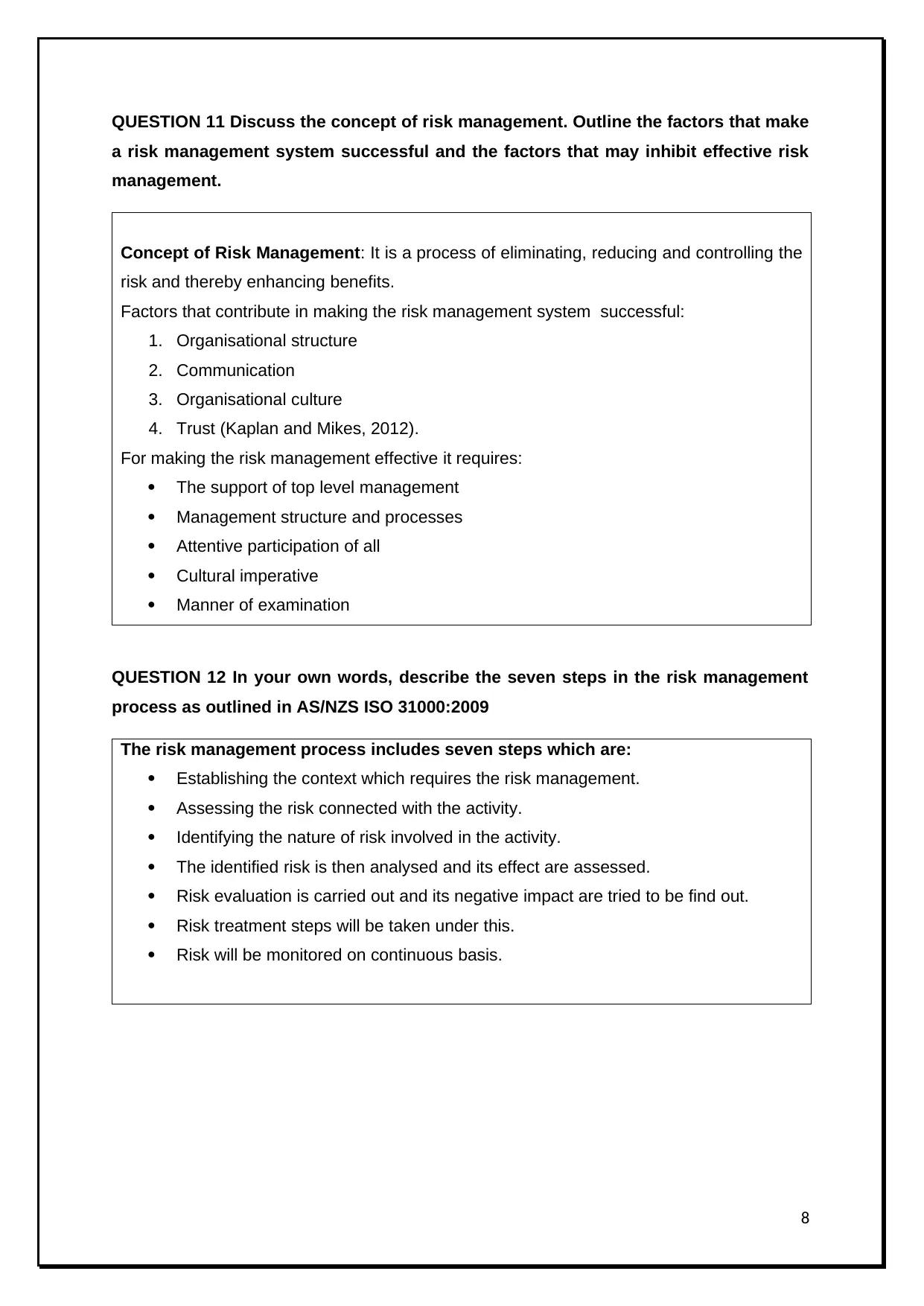
QUESTION 11 Discuss the concept of risk management. Outline the factors that make
a risk management system successful and the factors that may inhibit effective risk
management.
Concept of Risk Management: It is a process of eliminating, reducing and controlling the
risk and thereby enhancing benefits.
Factors that contribute in making the risk management system successful:
1. Organisational structure
2. Communication
3. Organisational culture
4. Trust (Kaplan and Mikes, 2012).
For making the risk management effective it requires:
The support of top level management
Management structure and processes
Attentive participation of all
Cultural imperative
Manner of examination
QUESTION 12 In your own words, describe the seven steps in the risk management
process as outlined in AS/NZS ISO 31000:2009
The risk management process includes seven steps which are:
Establishing the context which requires the risk management.
Assessing the risk connected with the activity.
Identifying the nature of risk involved in the activity.
The identified risk is then analysed and its effect are assessed.
Risk evaluation is carried out and its negative impact are tried to be find out.
Risk treatment steps will be taken under this.
Risk will be monitored on continuous basis.
8
a risk management system successful and the factors that may inhibit effective risk
management.
Concept of Risk Management: It is a process of eliminating, reducing and controlling the
risk and thereby enhancing benefits.
Factors that contribute in making the risk management system successful:
1. Organisational structure
2. Communication
3. Organisational culture
4. Trust (Kaplan and Mikes, 2012).
For making the risk management effective it requires:
The support of top level management
Management structure and processes
Attentive participation of all
Cultural imperative
Manner of examination
QUESTION 12 In your own words, describe the seven steps in the risk management
process as outlined in AS/NZS ISO 31000:2009
The risk management process includes seven steps which are:
Establishing the context which requires the risk management.
Assessing the risk connected with the activity.
Identifying the nature of risk involved in the activity.
The identified risk is then analysed and its effect are assessed.
Risk evaluation is carried out and its negative impact are tried to be find out.
Risk treatment steps will be taken under this.
Risk will be monitored on continuous basis.
8
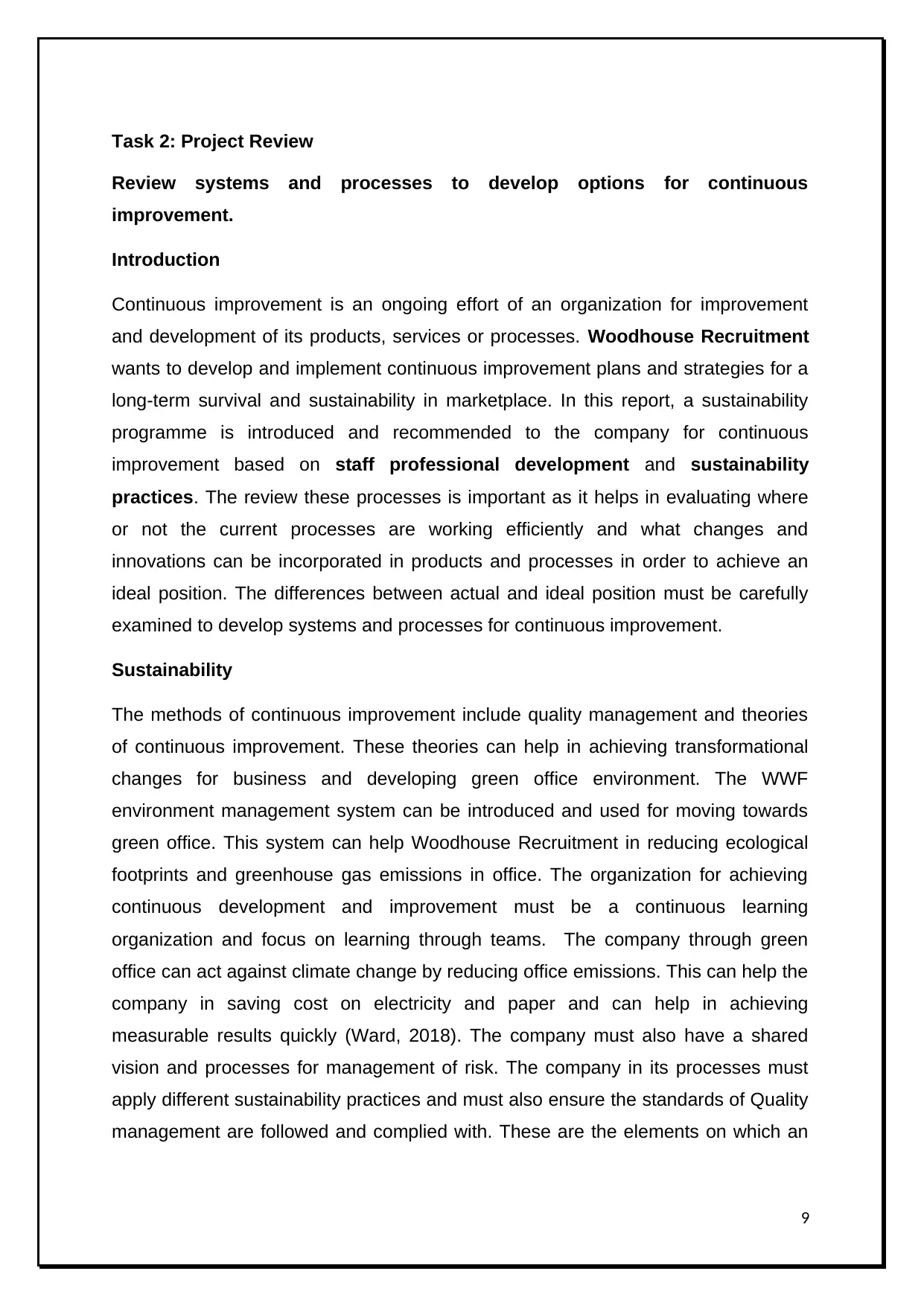
Task 2: Project Review
Review systems and processes to develop options for continuous
improvement.
Introduction
Continuous improvement is an ongoing effort of an organization for improvement
and development of its products, services or processes. Woodhouse Recruitment
wants to develop and implement continuous improvement plans and strategies for a
long-term survival and sustainability in marketplace. In this report, a sustainability
programme is introduced and recommended to the company for continuous
improvement based on staff professional development and sustainability
practices. The review these processes is important as it helps in evaluating where
or not the current processes are working efficiently and what changes and
innovations can be incorporated in products and processes in order to achieve an
ideal position. The differences between actual and ideal position must be carefully
examined to develop systems and processes for continuous improvement.
Sustainability
The methods of continuous improvement include quality management and theories
of continuous improvement. These theories can help in achieving transformational
changes for business and developing green office environment. The WWF
environment management system can be introduced and used for moving towards
green office. This system can help Woodhouse Recruitment in reducing ecological
footprints and greenhouse gas emissions in office. The organization for achieving
continuous development and improvement must be a continuous learning
organization and focus on learning through teams. The company through green
office can act against climate change by reducing office emissions. This can help the
company in saving cost on electricity and paper and can help in achieving
measurable results quickly (Ward, 2018). The company must also have a shared
vision and processes for management of risk. The company in its processes must
apply different sustainability practices and must also ensure the standards of Quality
management are followed and complied with. These are the elements on which an
9
Review systems and processes to develop options for continuous
improvement.
Introduction
Continuous improvement is an ongoing effort of an organization for improvement
and development of its products, services or processes. Woodhouse Recruitment
wants to develop and implement continuous improvement plans and strategies for a
long-term survival and sustainability in marketplace. In this report, a sustainability
programme is introduced and recommended to the company for continuous
improvement based on staff professional development and sustainability
practices. The review these processes is important as it helps in evaluating where
or not the current processes are working efficiently and what changes and
innovations can be incorporated in products and processes in order to achieve an
ideal position. The differences between actual and ideal position must be carefully
examined to develop systems and processes for continuous improvement.
Sustainability
The methods of continuous improvement include quality management and theories
of continuous improvement. These theories can help in achieving transformational
changes for business and developing green office environment. The WWF
environment management system can be introduced and used for moving towards
green office. This system can help Woodhouse Recruitment in reducing ecological
footprints and greenhouse gas emissions in office. The organization for achieving
continuous development and improvement must be a continuous learning
organization and focus on learning through teams. The company through green
office can act against climate change by reducing office emissions. This can help the
company in saving cost on electricity and paper and can help in achieving
measurable results quickly (Ward, 2018). The company must also have a shared
vision and processes for management of risk. The company in its processes must
apply different sustainability practices and must also ensure the standards of Quality
management are followed and complied with. These are the elements on which an
9
⊘ This is a preview!⊘
Do you want full access?
Subscribe today to unlock all pages.

Trusted by 1+ million students worldwide
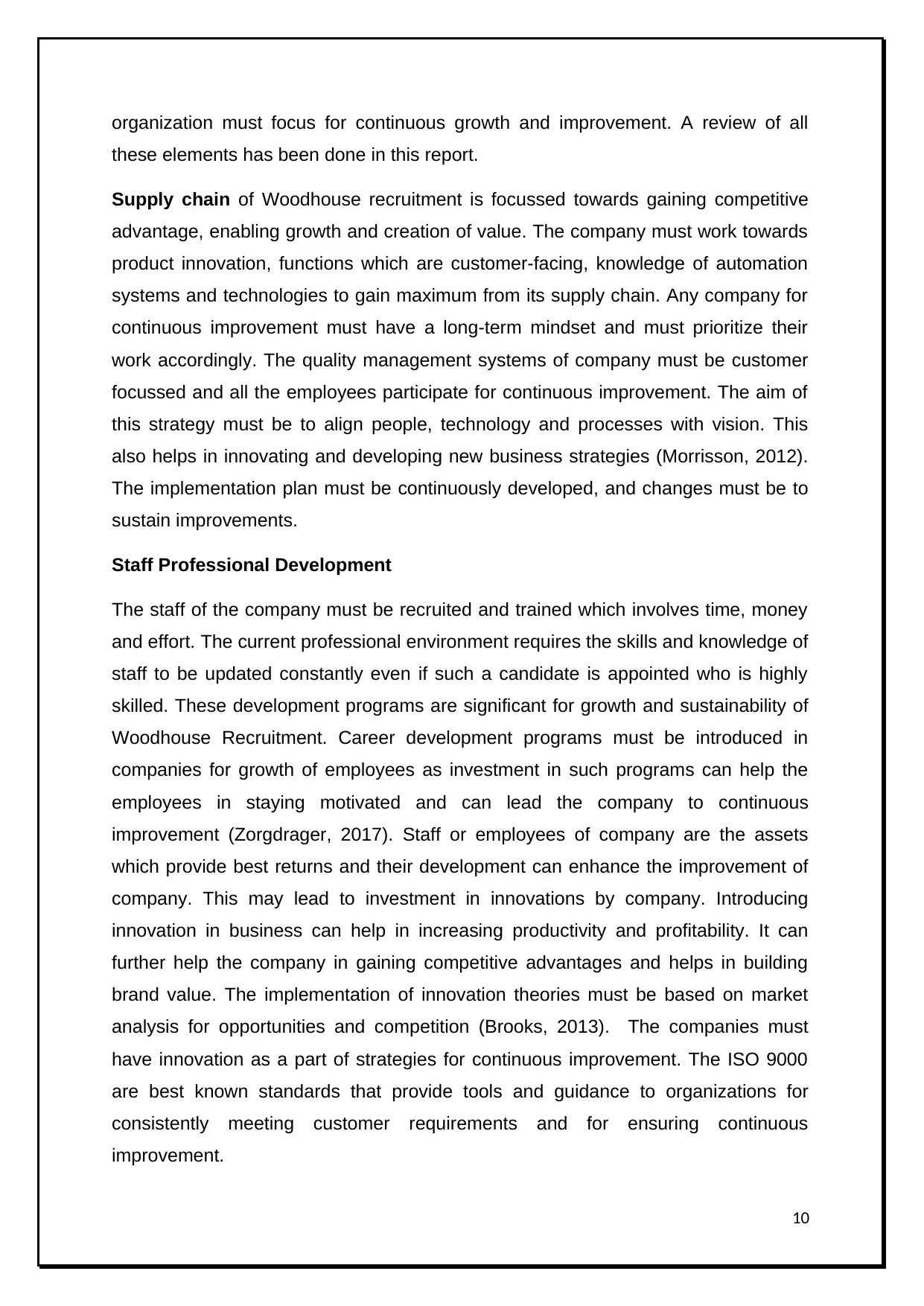
organization must focus for continuous growth and improvement. A review of all
these elements has been done in this report.
Supply chain of Woodhouse recruitment is focussed towards gaining competitive
advantage, enabling growth and creation of value. The company must work towards
product innovation, functions which are customer-facing, knowledge of automation
systems and technologies to gain maximum from its supply chain. Any company for
continuous improvement must have a long-term mindset and must prioritize their
work accordingly. The quality management systems of company must be customer
focussed and all the employees participate for continuous improvement. The aim of
this strategy must be to align people, technology and processes with vision. This
also helps in innovating and developing new business strategies (Morrisson, 2012).
The implementation plan must be continuously developed, and changes must be to
sustain improvements.
Staff Professional Development
The staff of the company must be recruited and trained which involves time, money
and effort. The current professional environment requires the skills and knowledge of
staff to be updated constantly even if such a candidate is appointed who is highly
skilled. These development programs are significant for growth and sustainability of
Woodhouse Recruitment. Career development programs must be introduced in
companies for growth of employees as investment in such programs can help the
employees in staying motivated and can lead the company to continuous
improvement (Zorgdrager, 2017). Staff or employees of company are the assets
which provide best returns and their development can enhance the improvement of
company. This may lead to investment in innovations by company. Introducing
innovation in business can help in increasing productivity and profitability. It can
further help the company in gaining competitive advantages and helps in building
brand value. The implementation of innovation theories must be based on market
analysis for opportunities and competition (Brooks, 2013). The companies must
have innovation as a part of strategies for continuous improvement. The ISO 9000
are best known standards that provide tools and guidance to organizations for
consistently meeting customer requirements and for ensuring continuous
improvement.
10
these elements has been done in this report.
Supply chain of Woodhouse recruitment is focussed towards gaining competitive
advantage, enabling growth and creation of value. The company must work towards
product innovation, functions which are customer-facing, knowledge of automation
systems and technologies to gain maximum from its supply chain. Any company for
continuous improvement must have a long-term mindset and must prioritize their
work accordingly. The quality management systems of company must be customer
focussed and all the employees participate for continuous improvement. The aim of
this strategy must be to align people, technology and processes with vision. This
also helps in innovating and developing new business strategies (Morrisson, 2012).
The implementation plan must be continuously developed, and changes must be to
sustain improvements.
Staff Professional Development
The staff of the company must be recruited and trained which involves time, money
and effort. The current professional environment requires the skills and knowledge of
staff to be updated constantly even if such a candidate is appointed who is highly
skilled. These development programs are significant for growth and sustainability of
Woodhouse Recruitment. Career development programs must be introduced in
companies for growth of employees as investment in such programs can help the
employees in staying motivated and can lead the company to continuous
improvement (Zorgdrager, 2017). Staff or employees of company are the assets
which provide best returns and their development can enhance the improvement of
company. This may lead to investment in innovations by company. Introducing
innovation in business can help in increasing productivity and profitability. It can
further help the company in gaining competitive advantages and helps in building
brand value. The implementation of innovation theories must be based on market
analysis for opportunities and competition (Brooks, 2013). The companies must
have innovation as a part of strategies for continuous improvement. The ISO 9000
are best known standards that provide tools and guidance to organizations for
consistently meeting customer requirements and for ensuring continuous
improvement.
10
Paraphrase This Document
Need a fresh take? Get an instant paraphrase of this document with our AI Paraphraser
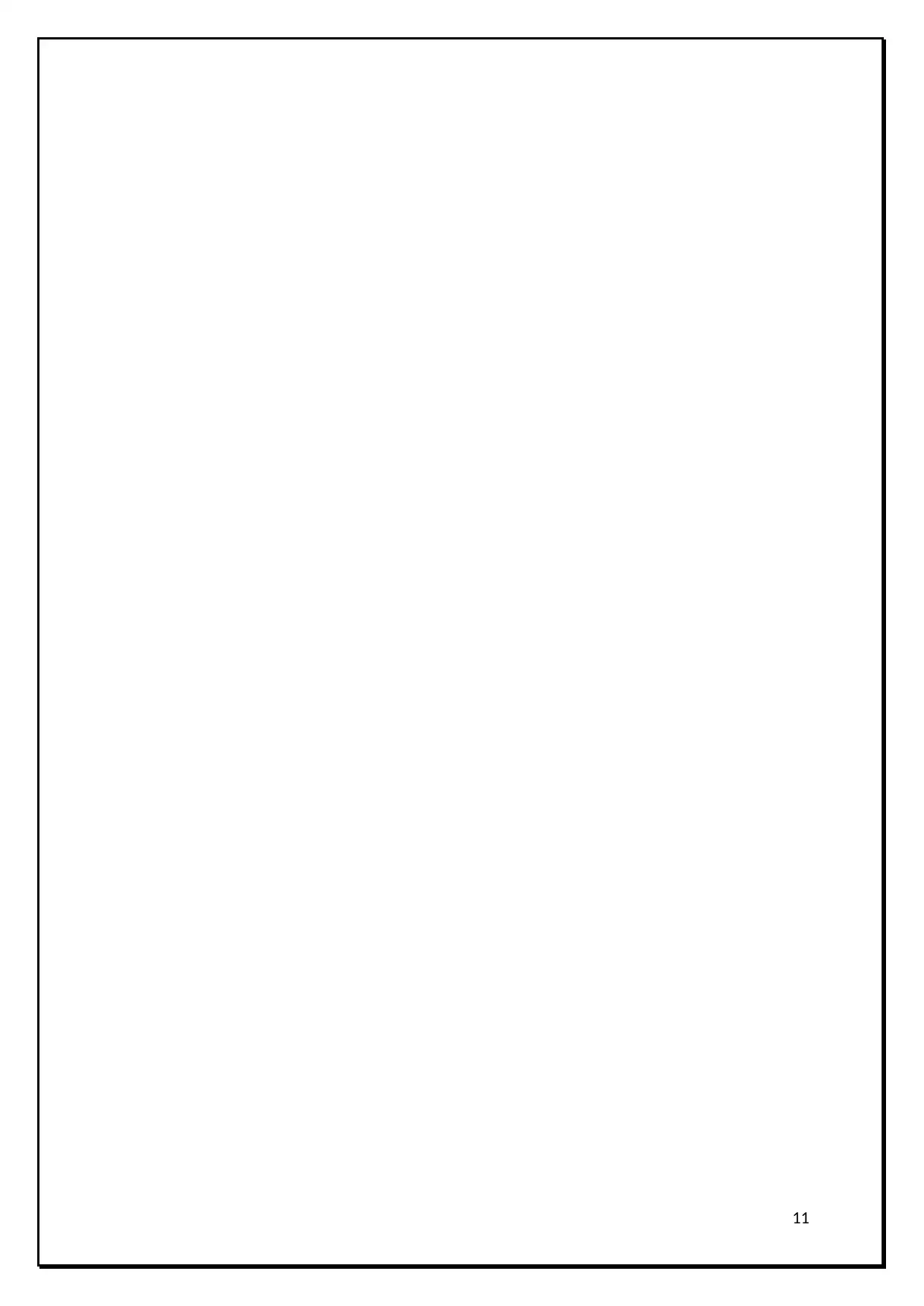
11
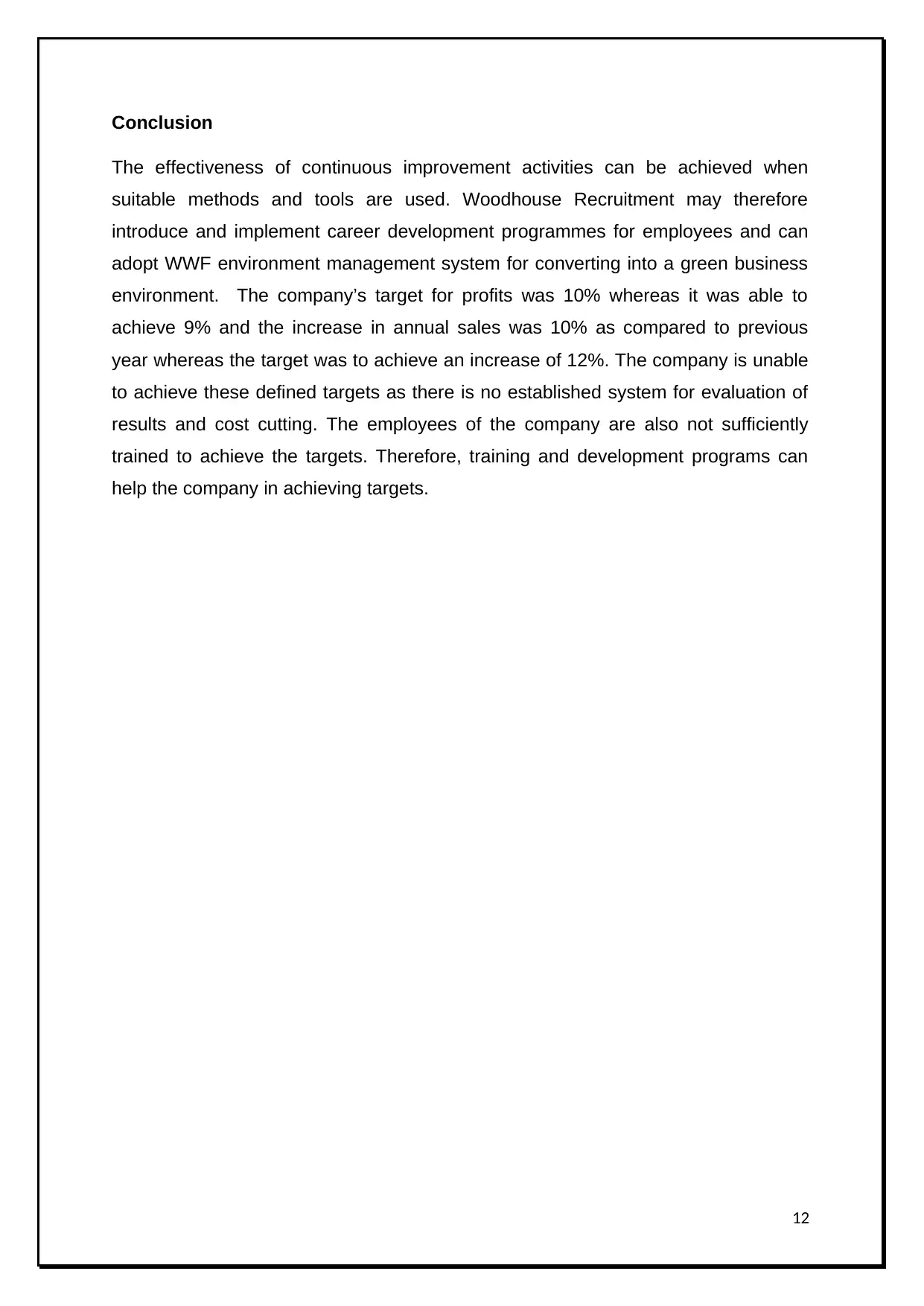
Conclusion
The effectiveness of continuous improvement activities can be achieved when
suitable methods and tools are used. Woodhouse Recruitment may therefore
introduce and implement career development programmes for employees and can
adopt WWF environment management system for converting into a green business
environment. The company’s target for profits was 10% whereas it was able to
achieve 9% and the increase in annual sales was 10% as compared to previous
year whereas the target was to achieve an increase of 12%. The company is unable
to achieve these defined targets as there is no established system for evaluation of
results and cost cutting. The employees of the company are also not sufficiently
trained to achieve the targets. Therefore, training and development programs can
help the company in achieving targets.
12
The effectiveness of continuous improvement activities can be achieved when
suitable methods and tools are used. Woodhouse Recruitment may therefore
introduce and implement career development programmes for employees and can
adopt WWF environment management system for converting into a green business
environment. The company’s target for profits was 10% whereas it was able to
achieve 9% and the increase in annual sales was 10% as compared to previous
year whereas the target was to achieve an increase of 12%. The company is unable
to achieve these defined targets as there is no established system for evaluation of
results and cost cutting. The employees of the company are also not sufficiently
trained to achieve the targets. Therefore, training and development programs can
help the company in achieving targets.
12
⊘ This is a preview!⊘
Do you want full access?
Subscribe today to unlock all pages.

Trusted by 1+ million students worldwide
1 out of 21
Related Documents
Your All-in-One AI-Powered Toolkit for Academic Success.
+13062052269
info@desklib.com
Available 24*7 on WhatsApp / Email
![[object Object]](/_next/static/media/star-bottom.7253800d.svg)
Unlock your academic potential
Copyright © 2020–2025 A2Z Services. All Rights Reserved. Developed and managed by ZUCOL.





